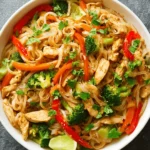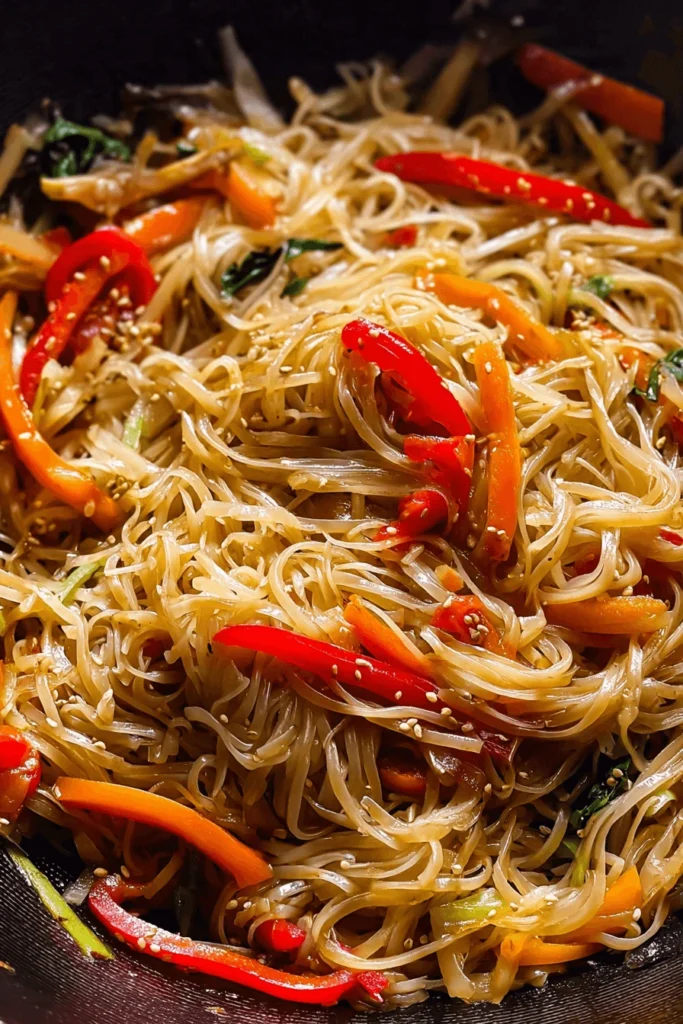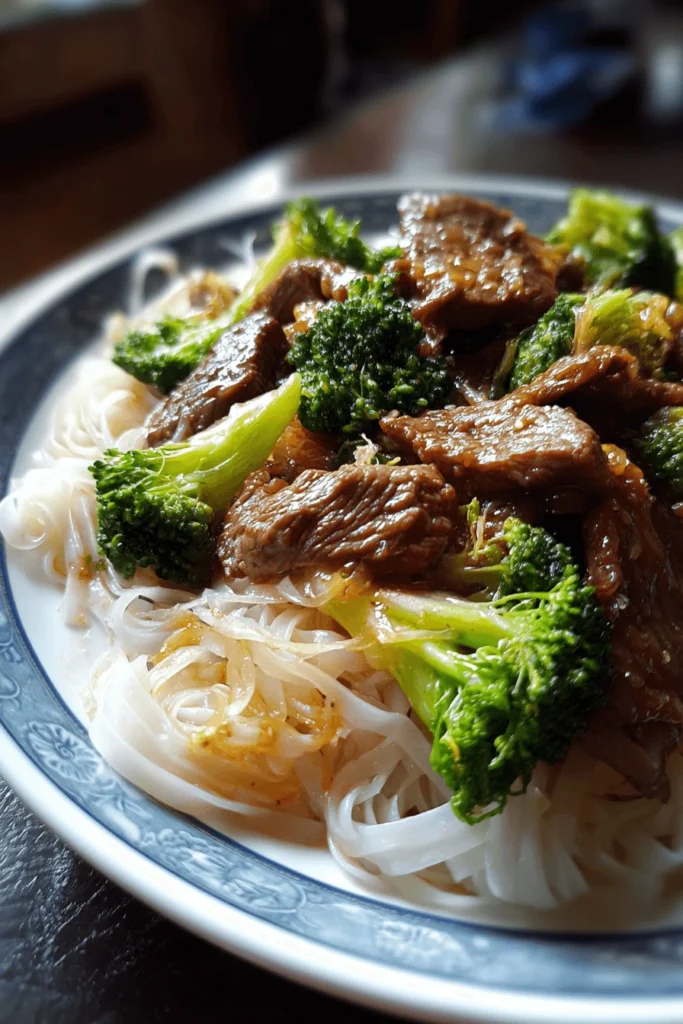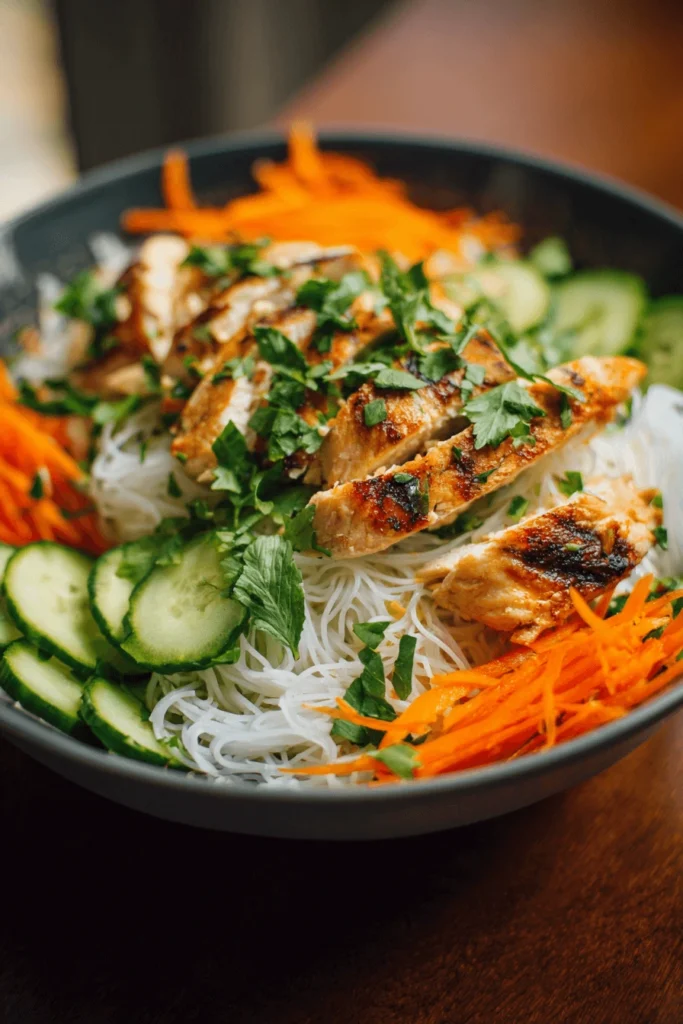Rice noodles may look humble, but don’t be fooled — they’ve got a way of sneaking into your pantry and staying there for good. Unlike the sometimes heavy, guilt-inducing pasta bowls we’ve all overindulged in, rice noodles come across as the lighter, fresher cousin who never makes you feel sluggish. Whether it’s in a sizzling rice noodle stir fry, a bowl of fragrant pho, or a quick weeknight rice noodles recipe that takes less time than deciding what to watch on Netflix, these noodles are versatile, tasty, and surprisingly easy to cook.
In this ultimate guide, we’ll dive into everything you need to know about rice noodles: their origins, health benefits, calorie count, the difference between flat rice noodles and thin ones, and even how to whip up restaurant-style rice noodles Chinese dishes at home. By the end, you’ll be equipped to cook, serve, and enjoy rice noodles like a pro.
Print
Quick Rice Noodle Stir Fry
- Total Time: 25 minutes
Ingredients
8 oz rice noodles (flat or thin)
2 tbsp vegetable oil
2 cloves garlic, minced
1 cup broccoli florets
1 bell pepper, sliced
1 carrot, julienned
1 cup cooked chicken, shrimp, or tofu
3 tbsp soy sauce
1 tbsp oyster sauce (optional)
1 tsp sesame oil
Lime wedges and cilantro for garnish
Instructions
Soak noodles in warm water until pliable, then drain.
Heat oil in wok, sauté garlic until fragrant.
Add vegetables and stir-fry 3–4 minutes.
Add protein, cook until heated.
Toss in noodles, soy sauce, oyster sauce; stir until coated.
Finish with sesame oil, garnish with lime and cilantro.
- Prep Time: 10 minutes
- Cook Time: 15 minutes
Nutrition
- Serving Size: 2–3
Table of Contents
What Are Rice Noodles?
Origins of Rice Noodles: From Chinese Kitchens to Global Plates
Rice noodles have been part of Asian cooking for centuries, with their earliest roots tracing back to China. In regions where wheat was scarce but rice was abundant, cooks discovered that ground rice flour could be transformed into long, soft noodles. From there, rice noodles spread across Southeast Asia—becoming the backbone of dishes like Thai pad thai, Vietnamese pho, and Chinese chow fun. Today, rice noodles are more than just a regional staple; they’re a global pantry item, showing up in kitchens from San Francisco to Sydney. What started as a clever use of rice has now become a worldwide comfort food.
Common Types: Thin, Thick, and Flat Rice Noodles
Not all rice noodles are created equal. Walk down the noodle aisle of an Asian grocery store, and you’ll find different widths, textures, and packaging styles.
- Thin Rice Noodles (Vermicelli): These delicate strands cook quickly and are perfect for fresh salads or light soups. They’re the star in Vietnamese spring rolls and bun bowls.
- Thick Rice Noodles: Chewier and sturdier, these noodles hold up well in stir-fries and hearty dishes. They’re great for soaking up sauces without falling apart.
- Flat Rice Noodles: Wide and slippery, flat rice noodles (sometimes called ho fun or chow fun) are iconic in Chinese stir-fry dishes, often tossed with beef, vegetables, and a savory sauce.
This variety is part of what makes rice noodles so versatile. Whether you’re craving something light or a dish that sticks to your ribs, there’s a rice noodle type that fits the bill.
Rice Noodles vs. Wheat Noodles: Texture, Taste, and Cooking Style
Rice noodles and wheat noodles may look similar on the plate, but the experience of eating them is totally different. Wheat noodles (like spaghetti, ramen, or udon) tend to be springy and chewy thanks to gluten. Rice noodles, on the other hand, are naturally gluten-free, making them softer and more delicate.
Cooking methods also vary. Wheat noodles are usually boiled in salted water, while rice noodles often require soaking before a quick boil or stir-fry. The taste is subtler too—rice noodles soak up the flavors of whatever sauce or broth they’re paired with rather than stealing the spotlight. That’s why they shine in dishes with bold seasonings like soy sauce, garlic, chili, or lemongrass.
If you’re used to Italian pasta, the switch to rice noodles may feel lighter, fresher, and easier to digest. And for anyone with gluten sensitivity, rice noodles provide a safe and tasty option without missing out on beloved noodle-based dishes.
Nutritional Profile of Rice Noodles
Calories and Macronutrients in Rice Noodles
Rice noodles may look delicate, but they pack a respectable nutritional punch. A standard one-cup serving of cooked rice noodles contains about 190 calories, with roughly 3 grams of protein, 1 gram of fat, and 42 grams of carbohydrates. That makes them a high-carb, low-fat option that’s lighter than many wheat-based noodles.
They’re also naturally gluten-free, which is a big win for people with celiac disease or gluten sensitivity. While rice noodles don’t offer as much protein or fiber as whole wheat pasta, they make up for it with easy digestibility and versatility in cooking.
Here’s a quick breakdown to give you a side-by-side look:
| Nutrient (per 1 cup, cooked) | Rice Noodles | Wheat Pasta |
|---|---|---|
| Calories | 190 | 220 |
| Protein | 3 g | 7 g |
| Fat | 1 g | 1 g |
| Carbohydrates | 42 g | 43 g |
| Fiber | <1 g | 2 g |
As the chart shows, rice noodles are slightly lower in calories but also lower in protein and fiber compared to pasta. This makes them ideal for lighter meals or recipes where the sauce and toppings do the heavy lifting.
Are Rice Noodles a Healthy Carb? Glycemic Index Explained
The health debate around rice noodles often comes down to their glycemic index (GI)—a measure of how quickly a food raises blood sugar. Rice noodles generally have a medium to high GI (between 61 and 92 depending on thickness and preparation), meaning they digest faster than whole wheat pasta or soba noodles.
Does that make them unhealthy? Not necessarily. Eaten in moderation and paired with fiber-rich vegetables and lean protein, rice noodles can be part of a balanced diet. For example, tossing them in a stir-fry with broccoli, carrots, chicken, or shrimp helps slow down digestion and keeps you feeling full longer.
So yes, rice noodles are a carb—but they’re a carb that works best when balanced with other wholesome ingredients.
Comparing Rice Noodles Nutrition to Pasta and Other Noodles
When it comes to noodle choices, people often wonder: are rice noodles better for you than pasta? The answer depends on your dietary needs.
- Pasta delivers more protein and fiber but also contains gluten.
- Rice noodles are lighter, easier to digest, and gluten-free but offer fewer nutrients.
- Other alternatives like zucchini noodles, soba noodles, or chickpea pasta each come with their own health perks.
If you’re managing calories or want a lighter option, rice noodles are a smart choice. For higher protein and fiber, whole grain or legume-based noodles might have the edge nutritionally. In the end, it’s not about picking a single “best” noodle, but about using each type in the right dish. Rice noodles truly shine in Asian recipes, where sauces and spices bring the flavors to life. Don’t miss our Pistachio Everything Guide for creative ideas that elevate everyday dishes.
Health Benefits of Rice Noodles
Gluten-Free Goodness: Why Rice Noodles Are Celiac-Friendly
One of the biggest selling points of rice noodles is that they’re naturally gluten-free. For people with celiac disease or gluten sensitivity, wheat-based noodles like spaghetti or ramen can cause digestive issues. Rice noodles, on the other hand, are safe and gentle on the stomach.
That’s why they’ve become a pantry staple for gluten-free households. Whether in a steaming bowl of pho or a rice noodles stir fry, you can enjoy the comfort of noodles without worrying about gluten. And unlike many gluten-free pasta substitutes that fall apart when cooked, rice noodles hold their shape beautifully when prepared correctly.
Digestibility and Lighter Alternative to Wheat-Based Pasta
Ever notice how a heavy plate of pasta can leave you feeling sluggish? Rice noodles offer a lighter experience. Since they’re made from just rice flour and water, they’re easier to digest and less likely to cause bloating.
They’re also lower in fat and calories than many wheat pasta varieties, which makes them a good choice if you’re aiming for lighter meals without sacrificing flavor. Pair them with lots of fresh vegetables, lean protein, or seafood, and you’ve got a meal that’s satisfying but won’t weigh you down.
Are Rice Noodles Better for You Than Pasta?
The big question many people ask: are rice noodles better for you than pasta? The answer depends on your perspective.
- If you need gluten-free options or want something lighter on digestion, rice noodles take the crown.
- If you’re looking for higher protein and fiber, traditional pasta or whole grain noodles might have an edge.
Think of rice noodles as a blank canvas. Their mild taste allows spices, sauces, and toppings to shine—especially in Asian-inspired dishes. Unlike pasta, which often dominates the plate, rice noodles play a supporting role, making the entire meal feel fresher and more balanced.
In short, rice noodles may not beat pasta in every nutritional category, but they bring unique health benefits that make them a worthwhile addition to your menu.
Cooking Rice Noodles Like a Pro
How to Cook Rice Noodles Without Breaking or Clumping
Cooking these noodles can seem tricky if you’ve never handled them before, but once you know the basics, they’re almost foolproof. Dried noodles usually need a short soak in warm water until they’re pliable, followed by a quick dip in boiling water for just a minute or two. Overcook them, and you’ll end up with a sticky mess. Undercook them, and they’ll be chewy and tough.
The trick is to soak first, boil second, rinse third. After draining, rinse under cold water to stop the cooking process and prevent clumping. A drizzle of sesame oil or vegetable oil also helps keep them separate if you’re not using them right away.
Tips for Stir-Frying Noodles for Perfect Texture
For stir-fries, timing is everything. The noodles should be slightly undercooked before they hit the pan, since they’ll continue to soften as they soak up sauce and heat. Use a wok or a wide skillet to give them space to move around—crowding the pan leads to clumps.

Pair them with crisp veggies like bell peppers, broccoli, or snap peas, and add protein such as chicken, shrimp, or beef strips. Toss in soy sauce, garlic, ginger, and a splash of lime juice, and you’ve got a simple noodle stir fry that rivals takeout.
Mistakes to Avoid When Preparing Rice Noodles
Even experienced cooks run into problems, so here are the most common mistakes and how to avoid them:
- Boiling too long: Unlike pasta, these noodles don’t need more than a couple of minutes in hot water.
- Not rinsing: Skipping the rinse leaves them gummy and hard to separate.
- Adding to the stir-fry too early: They can turn mushy if left in sauce for too long. Always cook vegetables and proteins first, then add the noodles at the end.
- Using the wrong type: Thin vermicelli suits soups and salads, while flat rice noodles shine in chow fun or pad see ew. Choosing the right thickness makes all the difference.
Master these steps, and you’ll have noodles that are silky, tender, and ready to take on any flavor combination. For a versatile ingredient that works in both sweet and savory recipes, check out our Stretchy Yogurt Guide and discover tips to enhance your cooking.
Popular Rice Noodle Dishes Around the World
Chinese Rice Noodles Classics (Chow Fun, Ho Fun, Mei Fun)
In Chinese cuisine, noodles aren’t just food—they’re a symbol of longevity and prosperity. Among the most famous are chow fun and ho fun, both made with wide, flat strips that soak up savory sauces. Stir-fried with beef, soy sauce, and bean sprouts, they deliver that iconic smoky “wok hei” flavor.

Then there’s mei fun, a thin noodle variety often paired with shrimp, chicken, or vegetables. It’s light, quick to cook, and perfect for those who want a dish that’s flavorful but not heavy. These classics show just how versatile rice-based noodles can be across different Chinese cooking styles.
Thai and Vietnamese Rice Noodle Dishes (Pad Thai, Pho, Bun)
No global noodle tour would be complete without a stop in Thailand and Vietnam.
- Pad Thai: Probably the world’s most famous rice noodle stir fry, pad Thai combines noodles with eggs, tofu or shrimp, bean sprouts, peanuts, and a tangy-sweet sauce. It’s a dish that balances salty, sour, sweet, and spicy in every bite.
- Pho: Vietnam’s signature noodle soup, featuring flat noodles in a fragrant broth simmered with spices, fresh herbs, and thin slices of beef or chicken. A bowl of pho is both comfort food and culinary art.
- Bun: A chilled noodle salad that mixes vermicelli with grilled meats, fresh herbs, and fish sauce dressing. It’s refreshing and perfect for hot summer days.
These dishes highlight how different regions use the same simple ingredient to create meals with unique personalities.
Creative Rice Noodle Recipe Ideas for Home Cooks
While traditional dishes are amazing, rice noodles are just as fun to experiment with in your own kitchen. Here are some ideas:
- Noodle stir fry with seasonal veggies — quick, healthy, and customizable.
- Flat noodles tossed with beef and broccoli for a hearty dinner.
- Cold noodle salad with cucumbers, carrots, and a sesame dressing—light yet satisfying.
- Spicy noodle soup with chicken broth, chili paste, and fresh herbs for a homemade comfort bowl.
The beauty of these noodles lies in their adaptability. They absorb flavors beautifully, whether you’re working with soy-based sauces, curry, or citrusy marinades. With a few pantry staples, you can whip up dishes that feel restaurant-worthy in less than 30 minutes.
Rice Noodles in Stir Fry and Soups
Best Vegetables, Meats, and Alternatives to Pair with Rice Noodles
What makes these noodles so fun to cook with is their ability to adapt to almost any pairing. For a well-balanced stir fry, crisp vegetables like broccoli, bell peppers, snow peas, and carrots add crunch and color. Leafy greens such as bok choy or spinach also blend beautifully with the soft texture of the noodles.
Protein choices are wide open. Popular picks include chicken, shrimp, beef, or tofu, but don’t overlook turkey bacon, chicken sausage, or even lamb for something different. Since the noodles themselves are mild, the flavors of your toppings shine through, making every bite a fresh surprise.
Rice Noodle Stir Fry Recipe for Busy Weeknights
A stir fry is one of the easiest ways to put dinner on the table fast. Here’s a simple version that’s both healthy and satisfying:
Quick Rice Noodle Stir Fry
- Ingredients:
- 8 oz dried noodles (flat or thin)
- 2 tbsp vegetable oil
- 2 cloves garlic, minced
- 1 cup broccoli florets
- 1 bell pepper, sliced
- 1 carrot, julienned
- 1 cup cooked chicken or shrimp
- 3 tbsp soy sauce
- 1 tbsp oyster sauce (optional)
- 1 tsp sesame oil
- Fresh lime wedges and cilantro for garnish
Instructions:
- Soak noodles in warm water until pliable, then drain.
- Heat oil in a wok or large skillet. Add garlic and sauté until fragrant.
- Toss in vegetables and stir-fry for 3–4 minutes.
- Add protein and continue cooking.
- Toss in the noodles, soy sauce, and oyster sauce. Stir until coated.
- Finish with sesame oil, garnish with lime and cilantro, and serve hot.
This quick stir fry hits all the right notes—savory, fresh, and satisfying without being heavy.
Comforting Rice Noodle Soups: Asian-Inspired Bowls
When the weather cools down, a warm bowl of soup is hard to beat. Rice noodles shine in soups because they soak up broths while staying tender.
- Classic Chicken Noodle Soup with a Twist: Swap pasta for rice noodles to make it gluten-free and lighter.
- Spicy Lemongrass Broth: Add thin noodles, mushrooms, and shrimp for a Southeast Asian kick.
- Beef and Flat Noodle Soup: A rich broth simmered with star anise and cinnamon creates deep flavor reminiscent of pho.
Soups with rice noodles aren’t just filling—they’re customizable, letting you use whatever vegetables and proteins you have on hand.
If you’re thinking about a light dessert after your noodle dishes, try our Mini Egg Cheesecake Recipe for a sweet finish that’s easy to make.
Comparing Rice Noodles with Other Noodles
Rice Noodles vs. Regular Noodles: Key Differences
At first glance, all noodles look like, well… noodles. But bite into them, and the differences become clear. Regular noodles—think spaghetti, ramen, or udon—are made with wheat flour and water. Thanks to gluten, they have a chewy, springy bite that holds up in rich sauces.
Rice noodles, on the other hand, are made from just rice flour and water. This makes them naturally gluten-free, softer in texture, and lighter on the stomach. They also absorb sauces and broths more easily, which is why they’re staples in Asian dishes where bold seasonings carry the flavor.
The choice often comes down to the dish you’re making. For Italian recipes, wheat pasta still reigns supreme. For a rice noodles stir fry, pho, or chow fun, rice noodles fit the bill perfectly.
Which Noodle Raises Blood Sugar Faster?
Carbohydrates can affect blood sugar differently depending on their type. Wheat-based noodles usually have a lower glycemic index (GI) compared to rice noodles, meaning they raise blood sugar more slowly. Rice noodles generally fall in the medium to high GI range, so they can cause a quicker spike.
Does that mean they’re “bad”? Not necessarily. The trick is in what you pair them with. Adding fiber-rich vegetables, lean protein, and healthy fats slows down digestion and keeps blood sugar steadier. So while plain noodles on their own might spike levels, a balanced bowl with broccoli, chicken, and sesame oil paints a healthier picture.
What Is the Healthiest Noodle Option Overall?
There isn’t a single “healthiest” noodle—it really depends on your needs. Here’s a quick comparison:
| Noodle Type | Key Benefit | Best Use Case |
|---|---|---|
| Rice Noodles | Gluten-free, light, easy to digest | Stir fry, soups |
| Whole Wheat Pasta | High fiber, more protein | Italian-style dishes |
| Soba (Buckwheat) | Rich in nutrients, earthy flavor | Salads, light stir-fries |
| Zucchini Noodles | Very low calorie, high in vitamins | Low-carb diets |
| Chickpea Pasta | High protein, gluten-free | Balanced meals |
For people who want something light and gluten-free, rice noodles are an excellent choice. For those who need more protein and fiber, soba or chickpea pasta might be better. The healthiest option is often the one that matches your personal health goals and the dish you’re preparing.
Buying, Storing, and Choosing Rice Noodles
How to Choose the Right Thickness: Thin, Thick, or Flat Rice Noodles
Walk into any Asian grocery store—or even the international aisle of your local supermarket—and you’ll likely face a wall of noodle options. The key is knowing which type works best for the dish you’re planning.
- Thin Vermicelli: Ideal for salads, spring rolls, or light soups. They cook fast and absorb flavor quickly.
- Thick Rice Noodles: Best for hearty stir-fries where the noodles need to hold up against sauces and chunky vegetables.
- Flat Rice Noodles: Wide and silky, these are perfect for dishes like chow fun, pad see ew, or beef stir fry with broccoli.
Choosing the right noodle width ensures your dish comes out authentic and balanced, rather than soggy or overpowered.
Storage Tips: Dried vs. Fresh Rice Noodles
How you store your noodles depends on the type you buy.
- Dried Rice Noodles: The most common variety in U.S. grocery stores. They’re shelf-stable and can last for months in a cool, dry pantry. Just keep them sealed to prevent moisture.
- Fresh Rice Noodles: Found in refrigerated sections of Asian supermarkets. They have a softer texture but a shorter shelf life—usually just a few days. For best results, use them quickly or freeze them in an airtight container.
A quick tip: once cooked, don’t leave rice noodles sitting out for too long. They tend to clump and harden, so it’s best to cook them right before serving.
Best Brands and Shopping Tips in the USA
If you’re shopping in the U.S., you’ll find plenty of quality options:
- Thai Kitchen — Widely available and a great starter brand for beginners.
- Annie Chun’s — Known for gluten-free, easy-to-use packaging with reliable texture.
- Three Ladies Brand — Popular in Asian grocery stores, especially for flat rice noodles.
- Mama Brand — A solid choice for authentic-tasting stir fry or noodle soups.
When buying, always check the label. The best rice noodles have just two ingredients: rice flour and water. Avoid brands with unnecessary additives or starches, which can affect texture and taste.
Creative Rice Noodle Recipes to Try at Home
Quick Weeknight Rice Noodle Stir Fry with Veggies
Weeknights call for something fast, flavorful, and fuss-free. A simple stir fry with rice noodles fits the bill perfectly. Use thin or thick noodles, sautéed vegetables, and your choice of protein—chicken, shrimp, or tofu all work wonderfully. Add garlic, soy sauce, and a splash of sesame oil for a meal that comes together in under 20 minutes.
Tips for success: soak the noodles first, cook veggies just until tender-crisp, and toss everything at the last minute to keep noodles from sticking. The result? A satisfying dinner that feels both homemade and restaurant-worthy.

Flat Rice Noodles with Beef and Broccoli
For a heartier option, flat rice noodles paired with beef and broccoli are a classic choice. The wide noodles soak up savory sauce while the broccoli adds crunch. Use lean beef strips or substitute with turkey ham or chicken sausage if you want to keep it lighter. A touch of garlic and ginger completes this Asian-inspired dish, perfect for impressing guests or enjoying a cozy night in.
Light and Healthy Rice Noodle Salad with Herbs
Cold rice noodle salads are refreshing, easy, and ideal for lunch or a picnic. Combine thin vermicelli noodles with fresh herbs like cilantro, mint, and basil. Add julienned carrots, cucumbers, and bell peppers, then dress with a simple mixture of lime juice, a little soy sauce, and a hint of sesame oil. Top with grilled chicken, shrimp, or tofu for extra protein.
This recipe shows just how versatile rice noodles can be—they shine hot or cold, stir-fried or fresh, simple or elaborate. Once you’ve mastered these basics, the sky’s the limit for creative variations using your favorite sauces, vegetables, and proteins.
FAQ Section
Are rice noodles better for you than pasta?
Rice noodles are lighter and naturally gluten-free, making them easier to digest. Pasta offers more protein and fiber, so the “better” choice depends on your dietary needs.
How do you cook rice noodles?
Soak them in warm water until pliable, then briefly boil or stir-fry. Avoid overcooking to prevent clumping. Rinse with cold water if not using immediately.
Are rice noodles a healthy carb?
Yes, when eaten in moderation and paired with vegetables and protein. They are a medium to high glycemic carb, so balancing them is key.
What is the difference between rice noodles and regular noodles?
Rice noodles are made from rice flour and water, gluten-free, and softer in texture. Regular noodles are wheat-based and chewier due to gluten content.
Do rice noodles raise blood sugar?
They can, due to their medium to high glycemic index, but pairing them with fiber, protein, and healthy fats slows digestion and stabilizes blood sugar.
What is the healthiest noodle?
The healthiest noodle depends on your goals: rice noodles for gluten-free and light meals, soba for nutrient density, whole wheat for fiber, or zucchini/chickpea noodles for low-calorie or high-protein options.
Conclusion: Why Rice Noodles Deserve a Place in Your Kitchen
From silky flat rice noodles to delicate thin vermicelli, these noodles are versatile, quick to cook, and easy on digestion. They absorb flavors beautifully, pair with endless ingredients, and fit into both light and hearty meals. Whether you’re making a quick stir fry, a comforting soup, or a refreshing noodle salad, rice noodles prove they’re more than just a simple pantry staple—they’re a canvas for creativity in the kitchen.
Find more delicious recipes on DifferentyRecipes Pinterest, and stay inspired with the newest tips and ideas by following DifferentyRecipes on Facebook.
